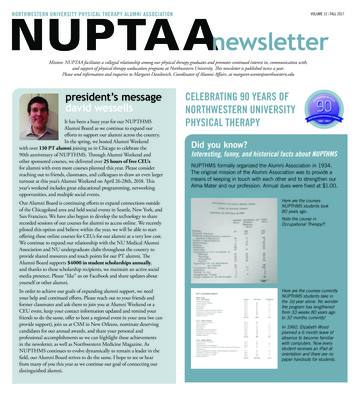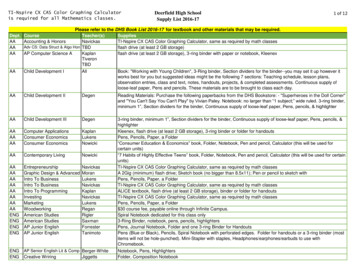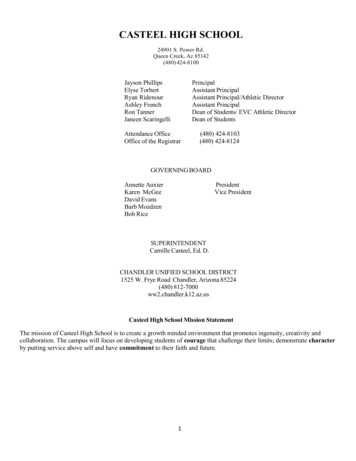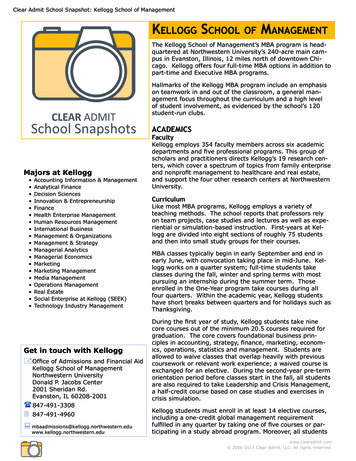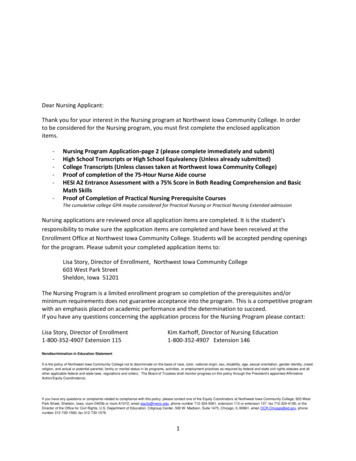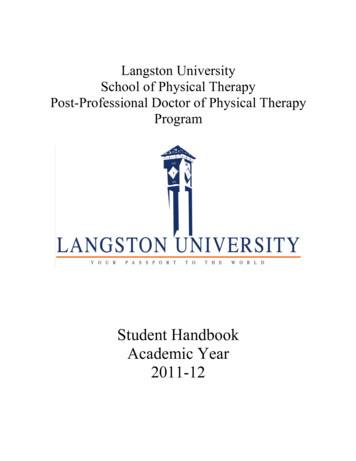
Transcription
Langston UniversitySchool of Physical TherapyPost-Professional Doctor of Physical TherapyProgramStudent HandbookAcademic Year2011-12
2
TABLE OF CONTENTSLetter from the Director of Post Professional DPT Program . Page 1Course of Study. Page 2Purpose of the Handbook . Page 4School of Physical Therapy Faculty and Staff . Page 5Section 1.Post Professional Doctor of Physical Therapy Degree ProgramA.B.C.Background and Historical Information . Page 7Langston University Mission, Goals, and Core Values . Page 9School of Physical Therapy Philosophy, Mission,Program Goals and Expected Outcomes . Page 11Section 2.Academic Standards and Expectations . Page 13Section 3.Student Rights and PrivilegesA.B.C.D.Section 4.University Joint Statement on Academic Rights and Freedomof Students . Page 15Grievance Procedures and Due Process Page 16Policy and Procedures for filing a complaint tothe School of Physical Therapy . Page 18Filing a Complaint about the DPT Program to the Commissionon Accreditation of Physical Therapist Education (CAPTE) . Page 19DPT Program Policies, Procedures, and PracticesA.BC.D.E.F.G.H.I.J.K.L.M.N.O.P.Attendance and Course of Study Preparedness . Page 19Grading System . Page 21Professional Behavior . Page 22Curriculum Sequences . Page 23Registration. Page 24Student Advisement. Page 24Tuition and Fee . Page 25Immunization . Page 25Health Care Services and Campus . Page 26Financial Aid . Page 26Books, Materials, and Supplies . Page 26Library . Page 27Picture Identification . Page 27Computer Laboratory Use . Page 27Campus Parking. Page 28Faculty Meeting . Page 28i
Q.Section 5.Professional Behavior and Expectations of Graduate StudentsA.B.C.D.E.D.Section 6.School of Physical Therapy Building Resources . Page 36William H. Hale Student Center . Page 37Disability Services . Page 37Emergency and Safety Considerations . Page 38HousingA.B.C.D.Section 9.Electronic Communication Devices . Page 35Eating and Drinking . Page 36Student Campus Life and Student ServicesA.B.C.DSection 8.Conflict Resolution . Page 29The Honor System . Page 30Complying with Academic Rules and Regulations . Page 30Academic Integrity . Page 31The Use of Human Subjects in Clinical TeachingDemonstrations and Research . Page 31Publication Policy . Page 33Laboratory Behavior and PracticesA.B.Section 7.Faculty Office Hours . Page 28University Residence Halls . Page 40Apartments . Page 41Family Housing . Page 41Off-Campus Housing. Page 41Graduation RequirementsA.B.C.D.E.Completion of Requirements for Graduation . Page 41University Requirements . Page 42Application for the Degree . Page 42Degree Awarded/Commencement. Page 42Alumni Information . .Page 42Appendices.Disability Accommodation Policy . Appendix AEmergency Preparedness Plan . Appendix Bii
iii
iv
Dear Post-Professional DPT Student:Welcome to Langston University and the School of Physical Therapy where you have enrolled tocomplete a post-professional physical therapy curriculum leading to the Doctor of Physical Therapy(DPT) degree. The education you will receive at Langston University supports the American PhysicalTherapy Association Vision 2010: “By 2020, physical therapy will be provided by physical therapistswho are doctors of physical therapy ”The administration, faculty, and staff have prepared a Student Handbook for the graduatestudents in the School of Physical Therapy. The Student Handbook supports the Universitypolicies and procedures, and describes the academic policies and procedures specific to the PostProfessional DPT program. You will find the Student Handbook helpful as you seek tounderstand important information regarding academic requirements, professional standards,ethical conduct for distance education on-line teaching and learning format.Each student is required to follow the policies and procedures defined in the Distance EducationManual, the School of Physical Therapy Post Professional DPT Student Handbook as well as inthe Langston University Catalogue. The student should read the various documents and meetwith his/her advisor to discuss any questions that may arise.Very truly yours,Millee Jorge, EdD PTDirector, Post Professional DPT1
Post Professional Doctor of Physical TherapyThe core curriculum requires completion of 18 credits from the following courses:PTPTPTPTPT71037113712371337253Research Methods*Evidence-Based MedicinePharmacology for Physical TherapistsDiagnostic Imaging for Physical TherapistsClinical Case Research CapstoneEvidence-Based Practice in one of the following:PT 7213 Evidence-Based Practice in Musculoskeletal PTPT 7223 Evidence-Based Practice in Neurological PTPT 7233 Evidence-Based Practice in Pediatric PTPT 7243 Evidence-based Practice in Geriatric itscreditscreditscredits*Persons with graduate level research course with a grade of B or better taken within the previous five years mayrequest to be exempt from the research course requirement.Persons with a Masters degree from an accredited institution must complete a minimum threecourses (9 credit hours) in addition to the core curriculum from the following list of 71737183719372037213722372337243Women’s HealthPublic Policy in Community HealthHealth Promotion and WellnessLegal and Ethical Practice in Physical TherapyMethods of Instruction and ConsultationExercise Science and Sports Physical TherapyPhysical Therapy Organization and ManagementEvidence-Based Practice in Musculoskeletal PTEvidence-Based Practice in Neurological PTEvidence-Based Practice in Pediatric PTEvidence-based Practice in Geriatric editscreditscredits*credits*credits*credits**Only one course in the evidence-based practice course series can be selected as an electivePersons with a baccalaureate degree with a physical therapy major from an accredited institutionmust complete a minimum of 7 courses (21 credit hours) in addition to the courses from thefollowing list of elective 719372037213722372337243Women’s HealthPublic Policy in Community HealthHealth Promotion and WellnessLegal and Ethical Practice in Physical TherapyMethods of Instruction and ConsultationExercise Science and Sports Physical TherapyPhysical Therapy Organization and ManagementEvidence-Based Practice in Musculoskeletal PTEvidence-Based Practice in Neurological PTEvidence-Based Practice in Pediatric PTEvidence-based Practice in Geriatric editscreditscredits*credits*credits*credits**Only two courses in the evidence-based practice course series can be selected as electives
Post Professional Doctor of Physical TherapyStudent HandbookAcademic Year 2011-12Purpose of the HandbookThe purpose of this handbook is to provide students with information that is specific to the PostProfessional Doctor of Physical Therapy DPT) degree program offered in the School of PhysicalTherapy at Langston University. The information presented in the handbook serves as areference to policies, procedures, requirements, rules, regulations, and general information thatapplies specifically to the graduate students enrolled in the program.Each student is required to follow the policies and procedures defined in this handbook as well asthose policies and procedures defined in the Langston University Catalogue. The catalogue isavailable on line at the Langston University website main page. (www.lunet.edu)Each entering Post Professional DPT student is required to review thoroughly the contents of theStudent Handbook, Distance Education Manual, and the Langston University Catalogue. Thestudent will meet with an assigned academic advisor to discuss the contents of the StudentHandbook, Distance Education Manual, and the Langston University Catalogue within the firstten (10) days after enrolling in the post professional DPT program. Upon reviewing anddiscussing the contents of the three documents, the student is required to sign a statementacknowledging the reading and understanding of these materials. Failure to comply with thisprocedural request will result in dismissal from the program.Assurance of Confidentiality StatementAdministration and faculty in the School of Physical Therapy respect the rights and privileges ofthe students and adhere to University policies on confidentiality of student informationpertaining to personal information, education history and academic performance, medical historyand immunizations, criminal background checks, and drug and alcohol testing. Studentinformation is protected by the Family Education Rights and Privacy Act (FERPA). Knowledgeabout students is strictly shared on a “need-to-know” only basis.3
School of Physical Therapy Faculty and StaffAliya Chaudry, PT, MBA, JDDean School of Physical TherapyDirector of Clinical EducationAssociate Professorachaudry@lunet.edu(405) 466-3255Millee Jorge, PT, Ed.D.Director, Post-Professional DPTProfessormjorge@lunet.edu(405) 466-3427(540) 769-9448Theresa Nemmers, PT, PhD, GCFP Director of ResearchAssociate Professortmnemmers@lunet.edu(405) 466-3699Daniel H. Riddick, MD, PhDProfessordriddick@lunet.edu(405) 466-2925(540) 489-0099Elicia Pollard, PT, PhDAssistant Professorepollard@lunet.edu(405) 466-2923Theresa E. Leahy, PT, MHS, NCSAssistant Professorteleahy@lunet.edu(405) 466-3564Philip George, MBBS, MS, PhDAssistant Professorpgeorge@lunet.edu(405) 466-36114
Administrative StaffMs. Cheryle LeachAdministrative Specialistcrleach@lunet.edu(405) 466-3697Ms. Betty Adams,Administrative Assistant, Clinical Educationbcadams@lunet.edu(405) 466-3487Ms. Samantha CorbettAdministrative Assistant, Post Professional DPT Programsjcorbett@lunet.edu(405) 466-29255
Section 1: Post Professional Doctor of Physical Therapy Degree ProgramIntroductionThe Langston University Post Professional Doctor of Physical Therapy course of study leads tothe terminal degree of Doctor of Physical Therapy (DPT). The course of study is a graduatedegree program for physical therapists that hold a baccalaureate or masters degree in physicaltherapy and are currently licensed to practice physical therapy in the United States. The proposedcourse of study for the DPT will advance the education of licensed physical therapists to thecurrent entry-level degree requirement which is a professional doctorate in physical therapy.The post professional curriculum is an on-line degree offered on a part-time basis that can becompleted in as little as four semesters. The applicant with a baccalaureate degree in physicaltherapy who does not have an advanced Masters degree will need to complete 18 credit hours ina series of required “core” courses and a minimum of 21 credit hours in elective courses. A totalof 39 credit hours are required for completion of the course requirements for licensed physicaltherapists that hold a baccalaureate degree in physical therapy. Applicants with a Masters degreeor higher will need to complete 18 credit hours in a series of required “core” courses and aminimum of 9 credit hours in elective courses. A total of 27 credit hours are required forcompletion of the course requirements for licensed physical therapists that hold a Mastersdegree. A clinical research capstone course is required of each student. The student is required tocome on the campus one time at the end of their course of study to present their capstoneresearch project.Background and Historical InformationHistory of Langston UniversityLangston University was established on March 12, 1897 in Langston, Oklahoma, by theTerritorial Legislature as the Colored Agricultural and Normal University for the expressedobjective of:“ the exclusive purpose of which shall be the instruction of both male and femalecolored persons in the art of teaching various branches which pertain to a common schooleducation and in which higher education as may be deemed advisable, and in thefundamental laws of the United States in the rights and duties of citizens in theagricultural, mechanical, and industrial arts.”6
On September 3, 1898, the school was opened in a Presbyterian Church in Langston, Oklahoma.The initial budget was five thousand dollars. Dr. Inman E. Page was the first president. He wasthe son of former slave who had purchased freedom for himself and his family. During the Pageadministration the campus expanded to one hundred and sixty acres. Student enrollmentincreased from forty-one students to six hundred and fifty students. The faculty increased fromfour to thirty five.In 1941 a unified system of higher education, The Oklahoma State System of Higher Education,was created by a constitutional amendment. At that time, the popularly known name “LangstonUniversity” became the official name of this institution.Since May of 1954, admission to Langston University has been based on stated academicrequirements regardless of race, creed, color, national origin, sex, or age. Langston University isan institution of equal opportunity for all individuals seeking employment at the university.History of Physical Therapy Education at Langston UniversityPhysical therapy education at Langston University began in 1986. The physical therapyeducation program was a five-year undergraduate program that accepted traditionalundergraduate students. The program was designed as a three-year pre-professional course ofstudy followed by a two-year professional physical therapy education. Langston Universityphysical therapy department graduated physical therapy students for thirteen consecutive yearsextending from 1988-2000. In 2002 Langston University developed the post-baccalaureate firstprofessional degree leading to the Doctor of Physical Therapy degree. In 2010 the OklahomaState Regents for Higher Education approved the Post Professional DPT program to be deliveredin distance education.Langston University Vision, Mission, Goals, and Core ValuesVISION STATEMENTLangston University, a land grant historically Black institution of higher-learning, will continueits rich tradition of developing leaders from a diverse, multi-cultural student body throughexcellent teaching, research, community service and public and private sector partnerships. AsLangston University moves from Excellence to Greatness, it will be recognized for providingsolutions to problems facing underserved populations in Oklahoma, the nation, and the world.MISSION STATEMENTThe mission of Langston University is to provide excellent postsecondary education toindividuals seeking knowledge, skills, and attitudes that will enhance the human condition andpromote a world that is peaceful, intellectual, technologically advanced, and one that fulfills theneeds of nations and individuals alike. Langston University strives to educate individuals tobecome the leaders of tomorrow within their local, national, and global communities. Reflectingon the Langston University history as a land grant institution established in 1890 “to instructboth male and female Colored persons”, the mission of the University continues to be theeducation of African-Americans in the arts, sciences, humanities, business, agriculture,education, nursing and health professions. Langston University offers postsecondary education7
leading to associate, baccalaureate, master, and doctoral degree programs. As a University withan urban mission in a rural setting, Langston University has the challenge of educatingindividuals who will serve their communities in urban centers as well as rural communities. Tofulfill the mission, Langston University actively recruits faculty and students who support andcomplement the purpose and functions of the University.CORE VALUES Strong work ethic and dedication – We are united in our dedication to working as hardand as long as necessary in order to realize our vision of developing creative solutions tothe problems facing underserved populations in Oklahoma, the nation and the world. Passion for learning – Our zeal for knowledge, our quest to understand “why” and ourdesire to develop innovative answers, create a vibrant academic community. Courage to have exemplary character – We are building a community in which highethical and moral standards are maintained and valued by our faculty, staff and students. Excellence – We value, treasure and reward excellence in scholarship, teaching andcommunity service. Scholarly innovation and a commitment to scholarship – We are a community ofpragmatic intellectuals, using our knowledge to better our state, nation and the world. Appreciation of difference – We
Post Professional Doctor of Physical Therapy Student Handbook Academic Year 2011-12 Purpose of the Handbook The purpose of this handbook is to provide students with information that is specific to the Post Professional Doctor of Physical Therapy DPT) degree program offered in the School of Physical Therapy at Langston University.


